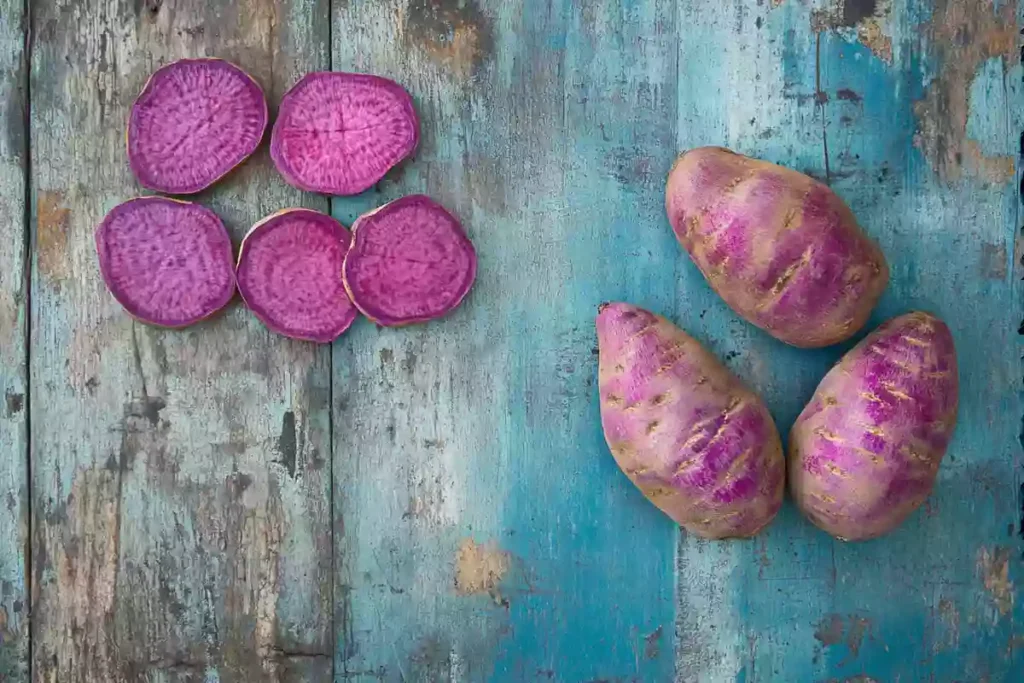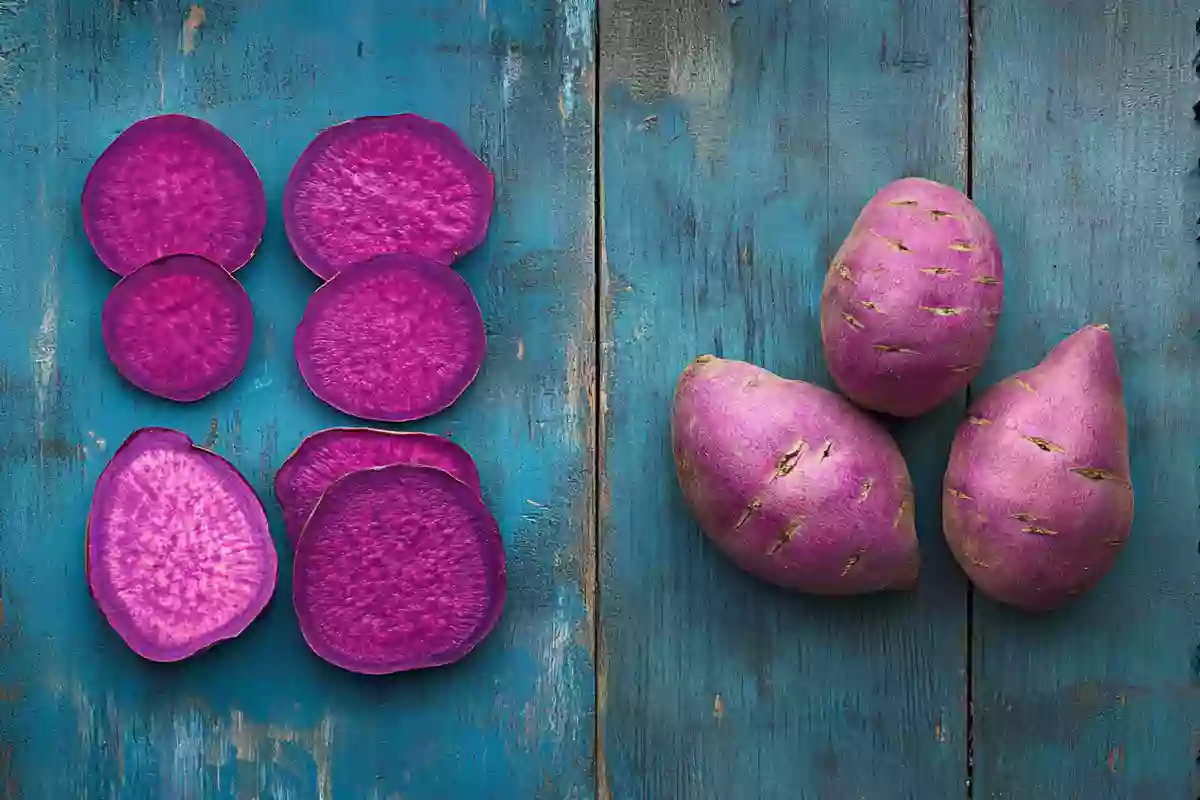Purple potatoes are a feast for the eyes and a treasure trove of nutrition. This article dives deep into these vibrant tubers, uncovering their origins, health benefits, and countless culinary possibilities. From understanding what makes them a superfood to exploring unique recipes and sustainability practices, you’ll discover why purple potatoes are stealing the spotlight in kitchens worldwide. Let’s get started!
Table of contents
Introduction to Purple Potatoes
What Are Purple Potatoes?
Purple potatoes are a variety of starchy root vegetables with eye-catching purple skin and flesh. Their vibrant hue comes from anthocyanins, a powerful group of antioxidants. These potatoes are part of the same family as regular white or yellow potatoes but stand out due to their striking color and unique nutrient profile.
Historical Background and Origins
Native to the Andes Mountains of South America, purple potatoes have been cultivated for centuries. Once a staple for ancient Peruvian civilizations, these potatoes were prized for their adaptability to harsh climates and their nutritional value. Over time, they gained popularity worldwide, becoming a favorite in modern kitchens.
Nutritional Overview of Purple Potatoes
Packed with essential vitamins and minerals, purple potatoes are a nutrient powerhouse. They’re rich in vitamin C, potassium, and iron, making them great for immune support and overall health. What sets them apart, however, is their high antioxidant content, which is linked to numerous health benefits, including reduced inflammation and improved heart health. Plus, they’re naturally low in fat and cholesterol, making them a guilt-free addition to your diet.
Nutritional and Health Benefits
Nutritional Profile of Purple Potatoes
Purple potatoes are packed with an impressive array of nutrients, making them a smart choice for any balanced diet. They boast a significant amount of vitamin C, essential for immune function, and potassium, which helps regulate blood pressure. Their standout feature is the abundance of anthocyanins, antioxidants responsible for their vibrant hue. These compounds are linked to numerous health benefits, including reduced inflammation and better cardiovascular health.
Key Antioxidants and Their Effects
The anthocyanins in potatoes don’t just make them look beautiful—they actively contribute to improved health. These antioxidants combat harmful free radicals, reducing the risk of chronic diseases like heart disease and cancer. Additionally, they play a role in improving brain function, offering protection against age-related cognitive decline.
How Purple Potatoes Compare to Other Potato Varieties
When it comes to nutritional value, potatoes hold their own against white and yellow potatoes. While all potatoes provide essential carbs and fiber, the antioxidant levels in purple varieties are substantially higher. This makes them a superior choice for individuals aiming to boost their intake of plant-based antioxidants.
Purple Potatoes for Heart Health and Blood Pressure Management
Rich in potassium, potatoes support heart health by balancing sodium levels and maintaining healthy blood pressure. Studies have shown that consuming them regularly can help lower systolic and diastolic blood pressure, thanks to their bioactive compounds.
Culinary Uses and Recipes
Popular Dishes Using Purple Potatoes
From hearty soups to crisp roasted sides, potatoes bring color and nutrition to any dish. Their firm texture makes them ideal for purple potato salads or creamy mashed potatoes. For those who enjoy vibrant plating, purple potato chips are a visual and flavorful treat.
Best Cooking Methods to Retain Nutritional Value
Preserving the nutrients in potatoes requires careful preparation. Steaming and baking are two of the best methods, as they prevent nutrient loss and enhance the natural flavors. Avoid frying, as it can diminish the antioxidant content and add unnecessary fats.
Global Recipes Featuring Purple Potatoes
potatoes are a staple in many international cuisines. Peruvian dishes like causa rellena often incorporate them for their vivid color and taste. In the United States, chefs love using potatoes to create eye-catching roasted medleys. In Asia, purple potato desserts, such as mochi and ice cream, showcase their versatility.
Tips for Buying and Storing Purple Potatoes
To ensure freshness, look for firm potatoes with smooth, blemish-free skins. Avoid those with soft spots or sprouts. Store them in a cool, dark place, away from direct sunlight, to prolong their shelf life and maintain their nutritional integrity.
Growing and Cultivating Purple Potatoes
Ideal Growing Conditions
potatoes thrive in cool climates with well-drained, nutrient-rich soil. These vibrant tubers need at least six hours of sunlight daily to develop their characteristic color and flavor. Proper spacing is essential to prevent overcrowding and ensure healthy growth. If you’re new to gardening, potatoes are relatively low-maintenance and can be grown in containers for smaller spaces.
Purple Potato Varieties: A Comparison
Several varieties of potatoes are available, each with its unique flavor and appearance. Purple Majesty, a popular choice, boasts deep purple flesh and a smooth texture, perfect for roasting or mashing. All Blue potatoes feature a slightly nutty taste and are ideal for colorful potato salads. These varieties not only taste great but also add visual appeal to your garden and table.
Organic vs. Conventional Farming
While conventional farming practices may yield higher volumes, organically grown potatoes offer several advantages. Organic methods avoid synthetic pesticides, making the produce safer for consumption and the environment. Additionally, organically grown potatoes tend to have a richer taste, allowing you to enjoy their natural goodness.
For more gardening inspiration and techniques, check out our article on vegetable cultivation tips.
Purple Potatoes as a Superfood
What Makes Purple Potatoes a Superfood?
Purple potatoes earn their superfood status thanks to their high concentration of antioxidants, vitamins, and minerals. The anthocyanins responsible for their striking color are known to reduce inflammation, improve circulation, and boost immune health. Compared to other potatoes, these nutrient-dense tubers pack a stronger nutritional punch.

Trends and Popularity in Modern Diets
The growing interest in plant-based and colorful diets has propelled potatoes into the spotlight. Their vibrant appearance and health benefits make them a favorite among health-conscious foodies and chefs. Whether used in Buddha bowls or trendy vegan dishes, potatoes add visual appeal and nourishment.
Purple Potatoes in Vegan and Gluten-Free Diets
For vegans and those with gluten sensitivities, potatoes are a versatile and safe option. They serve as an excellent base for creamy soups, baked fries, or even purple gnocchi. Their natural starchiness makes them a perfect ingredient in gluten-free recipes, catering to a wide array of dietary needs.
FAQs About Purple Potatoes
What Is Special About Purple Potatoes?
Purple potatoes stand out because of their unique color, rich taste, and impressive nutritional profile. Their vivid purple hue comes from anthocyanins, powerful antioxidants linked to numerous health benefits like reducing inflammation and supporting heart health. Beyond their striking appearance, they’re versatile in the kitchen, making them a favorite for both home cooks and chefs.
Do Purple Potatoes Taste Different?
Yes, potatoes have a slightly nutty and earthy flavor compared to regular white potatoes. While their taste isn’t drastically different, their denser texture and natural sweetness make them perfect for mashing, roasting, or baking. The subtle flavor works well in both savory and sweet dishes.
What Are Purple Potatoes Best For?
potatoes are incredibly versatile. They’re great for making purple potato chips, creamy mashed potatoes, or vibrant salads. Their bright color also holds up well in soups and stews, adding a unique visual and nutritional twist. If you enjoy experimenting in the kitchen, purple potatoes are a must-try ingredient.
Can You Eat the Skin on Purple Potatoes?
Absolutely! The skin of potatoes is rich in fiber and packed with nutrients like vitamin C. Keeping the skin on not only saves prep time but also adds extra texture and flavor to your dishes. Just be sure to wash them thoroughly before cooking.
Debunking Myths About Purple Potatoes
Are Purple Potatoes Genetically Modified?
No, potatoes are not genetically modified. They are naturally occurring varieties cultivated in the Andes for centuries. Their striking color is a natural trait derived from high levels of anthocyanins. Today, they are grown organically and conventionally without the need for genetic engineering.
Common Misconceptions About Their Nutrition
One common myth is that potatoes are less starchy than white potatoes. While their starch content is comparable, potatoes have the added benefit of higher antioxidant levels, making them a healthier choice. Another misconception is that their color fades when cooked—this is not true if they’re prepared correctly.
Addressing Concerns About Accessibility and Cost
Some people believe potatoes are hard to find or too expensive. While they may not be as common as white potatoes, many grocery stores now carry them, especially during peak seasons. Farmer’s markets and online produce retailers also make them more accessible than ever.
Sustainability and Purple Potatoes
Environmental Benefits of Growing Potatoes
Growing potatoes contributes to sustainable agriculture. These resilient crops adapt well to diverse climates and require fewer chemical inputs compared to other plants. Their ability to thrive in less fertile soil reduces the need for heavy fertilizers, making them an eco-friendly option for farmers and home gardeners alike. Plus, their natural disease resistance minimizes pesticide use.
Community Farming and Local Impact
potatoes often play a vital role in community farming initiatives. Small-scale farmers benefit from cultivating these potatoes due to their high market value and increasing demand. By purchasing locally grown potatoes, you can support local economies while reducing the carbon footprint associated with transporting produce long distances.
Sustainability Challenges in Mass Production
Despite their environmental benefits, large-scale production of potatoes can pose challenges. Over-farming and monoculture practices may deplete soil nutrients, making sustainable farming techniques essential. To ensure long-term availability, adopting crop rotation and organic farming practices can help maintain soil health while protecting these nutrient-rich tubers.
Conclusion and Final Thoughts
potatoes are more than just a pretty addition to your plate—they’re a nutritional powerhouse with endless culinary possibilities. From their rich antioxidant content to their role in promoting sustainable farming, these vibrant tubers have much to offer. Whether you’re incorporating them into a healthy diet, experimenting with global recipes, or supporting local agriculture, potatoes bring flavor and purpose to every meal.
Their growing popularity among health-conscious individuals and chefs worldwide highlights their versatility and appeal. These potatoes don’t just elevate your dishes aesthetically; they also add essential nutrients that support overall well-being. Whether you’re steaming, roasting, or baking, the possibilities are as colorful as the potatoes themselves.
So why not make purple potatoes a regular feature in your kitchen? With their unique taste, stunning appearance, and myriad of health benefits, they’re a fantastic way to mix up your meals while prioritizing your health and the environment.
For more creative recipe ideas and cooking tips, visit Menus Recipes.

